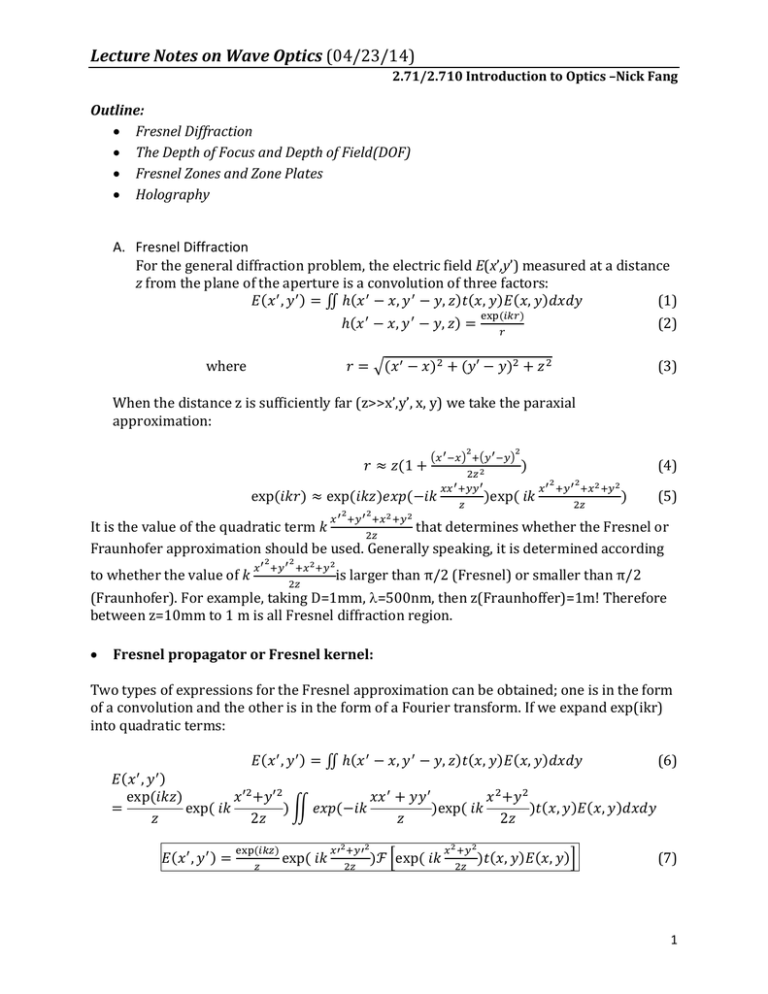
Lecture Notes on Wave Optics (04/23/14)
2.71/2.710 Introduction to Optics –Nick Fang
Outline:
Fresnel Diffraction
The Depth of Focus and Depth of Field(DOF)
Fresnel Zones and Zone Plates
Holography
A. Fresnel Diffraction
For the general diffraction problem, the electric field E(x’,y’) measured at a distance
z from the plane of the aperture is a convolution of three factors:
𝐸(𝑥 ′ , 𝑦 ′ ) = ∬ ℎ(𝑥 ′ − 𝑥, 𝑦 ′ − 𝑦, 𝑧)𝑡(𝑥, 𝑦)𝐸(𝑥, 𝑦)𝑑𝑥𝑑𝑦
(1)
exp
(
𝑖𝑘𝑟)
ℎ(𝑥 ′ − 𝑥, 𝑦 ′ − 𝑦, 𝑧) =
(2)
𝑟
𝑟 = √(𝑥 ′ − 𝑥)2 + (𝑦′ − 𝑦)2 + 𝑧 2
where
(3)
When the distance z is sufficiently far (z>>x’,y’, x, y) we take the paraxial
approximation:
2
𝑟 ≈ 𝑧(1 +
(𝑥 ′ −𝑥) +(𝑦′ −𝑦)
exp(𝑖𝑘𝑟) ≈ exp(𝑖𝑘𝑧)𝑒𝑥𝑝(−𝑖𝑘
′2
2𝑧 2
′
𝑥𝑥 +𝑦𝑦 ′
′2
𝑥 +𝑦 +𝑥 2 +𝑦 2
𝑧
2
)
)exp(𝑖𝑘
(4)
′2
′2
𝑥 +𝑦 +𝑥 2 +𝑦 2
2𝑧
)
(5)
It is the value of the quadratic term 𝑘
that determines whether the Fresnel or
2𝑧
Fraunhofer approximation should be used. Generally speaking, it is determined according
to whether the value of 𝑘
2
2
𝑥 ′ +𝑦 ′ +𝑥2 +𝑦2
2𝑧
is larger than π/2 (Fresnel) or smaller than π/2
(Fraunhofer). For example, taking D=1mm, =500nm, then z(Fraunhoffer)=1m! Therefore
between z=10mm to 1 m is all Fresnel diffraction region.
Fresnel propagator or Fresnel kernel:
Two types of expressions for the Fresnel approximation can be obtained; one is in the form
of a convolution and the other is in the form of a Fourier transform. If we expand exp(ikr)
into quadratic terms:
′
′)
𝐸(𝑥 ′ , 𝑦 ′ ) = ∬ ℎ(𝑥 ′ − 𝑥, 𝑦 ′ − 𝑦, 𝑧)𝑡(𝑥, 𝑦)𝐸(𝑥, 𝑦)𝑑𝑥𝑑𝑦
(6)
𝐸(𝑥 , 𝑦
exp(𝑖𝑘𝑧)
𝑥′2 +𝑦′2
𝑥𝑥 ′ + 𝑦𝑦 ′
𝑥 2 +𝑦 2
=
exp(𝑖𝑘
) ∬ 𝑒𝑥𝑝(−𝑖𝑘
)exp(𝑖𝑘
)𝑡(𝑥, 𝑦)𝐸(𝑥, 𝑦)𝑑𝑥𝑑𝑦
𝑧
2𝑧
𝑧
2𝑧
𝐸(𝑥 ′ , 𝑦 ′ ) =
exp(𝑖𝑘𝑧)
𝑧
exp(𝑖𝑘
𝑥′2 +𝑦′2
2𝑧
)ℱ [exp(𝑖𝑘
𝑥 2 +𝑦 2
2𝑧
)𝑡(𝑥, 𝑦)𝐸(𝑥, 𝑦)]
(7)
1
Lecture Notes on Wave Optics (04/23/14)
2.71/2.710 Introduction to Optics –Nick Fang
You may recognize exp(𝑖𝑘
the wavefront is diverging.
𝑥 2 +𝑦 2
2𝑧
) is a Gaussian function with respect to x and y, and
𝑧
𝑧
Using 𝑥′ = 𝑘𝑥 𝑘, 𝑦′ = 𝑘𝑦 𝑘
(8)
The corresponding transfer function is:
𝐻(𝑘𝑥 , 𝑘𝑦 ) =
exp(𝑖𝑘𝑧)
𝑥2 + 𝑦2
∬ 𝑒𝑥𝑝 (𝑖𝑘
) exp(−𝑖𝑘𝑥 𝑥 − 𝑖𝑘𝑦 𝑦) 𝑑𝑥𝑑𝑦
𝑧
2𝑧
𝐻(𝑘𝑥 , 𝑘𝑦 ) =
exp(𝑖𝑘𝑧)
𝑘
𝑒𝑥𝑝 (−𝑖𝑧
𝑘𝑥 2 +𝑘𝑦 2
2𝜋𝑘
)
(9)
The Fourier transform of a Gaussian function is still a Gaussian function. The above
property is often used in analyzing the depth of focus (DOF).
2
Lecture Notes on Wave Optics (04/23/14)
2.71/2.710 Introduction to Optics –Nick Fang
out-of-focus
object
B. The Depth of Focus (DOF)
δ
Aperture
(Fourier)
plane
object
plane
image
plane
When a focusing error z= is present in the imaging system, there is a difference of
path length from the “ideal” object plane. This means the field at the object plane is
of the form:
𝐸(𝑥, 𝑦) ⊗ exp(𝑖𝑘
𝑥 2 +𝑦 2
)
2𝛿
(10)
Correspondingly, the Fourier spectrum of the object is modified by 𝐻(𝑘𝑥 , 𝑘𝑦 ):
𝐸(𝑘𝑥 , 𝑘𝑦 ) × exp(−𝑖𝛿
𝑥′
𝑦′
𝑓1
𝑓1
𝑘𝑥 2 +𝑘𝑦 2
2𝑘
)
(11)
Keep in mind, 𝑘𝑥 = 𝑘 , 𝑘𝑦 = 𝑘 . Therefore, the effect of defocus is like a phase mask,
where the offset from the object plane create a quadratic phase shift for every k
component on the aperture plane. Correspondingly, the out-of-focus point spread
function is modified:
PSF(defocus)=ℱ [𝐴𝑆(𝑘𝑥
𝑓1
𝑘
𝑓
, 𝑘𝑦 𝑘1 ) × exp(−𝑖𝛿
𝑘𝑥 2 +𝑘𝑦 2
2𝑘
)]
(12)
The significance of the defocus: (Goodman 6.4.4)
Mild defocus: exp(−𝑖𝛿
𝑘𝑥 2 +𝑘𝑦 2
2𝑘
) ≈ 1 (13)
Re(ATF)
1
𝛿𝑘𝑥 2
2𝑘
This requirement is met when
𝛿
Or
𝑘𝑥 2
2𝑘
=
𝛿
2𝑘
𝛿𝑘
𝜆
𝜋
𝑥′
𝜋
𝑓1
2
(𝑘 )2 ≪
(𝑁𝐴)2 ≪ 1
𝛿 ≪ 2(𝑁𝐴)2 ≡ 𝐷𝑂𝐹 (DepthofFocus)
𝑘𝑥 =
(14)
(15)
(16)
2
2 𝛿
0
object spectrum
3
Lecture Notes on Wave Optics (04/23/14)
2.71/2.710 Introduction to Optics –Nick Fang
a.
Severe defocus: 𝛿
≥
𝜆
Re(ATF)
2(𝑁𝐴)2
𝛿𝑘𝑥 2
2𝑘
1
In this case, the oscillatory nature of
the defocus kernel results in strong
blur on the image because of the
suppression of spatial frequencies
near the nulls and sign changes at
the negative portions.
In focus
object
spectrum
0
𝑘𝑥 =
= 2DOF
2
2 𝛿
= 4DOF
© Source unknown. All rights reserved. This content is excluded from our Creative
Commons license. For more information, see http://ocw.mit.edu/fairuse.
Figure: Computed imaging of letter “M” convolved with diffraction-limited
PSF at different degrees of defocus.
Can the blur be undone computationally? (Goodman 8.8)
o Inverse of Fresnel propagator 𝐻(𝑘𝑥 , 𝑘𝑦 ) over distance z:
The problem of division is typically reduced to obtaining the
transmittance of the inverse, namely:
1
𝐻(𝑘𝑥 ,𝑘𝑦 )
=
𝐻 ∗ (𝑘𝑥 ,𝑘𝑦 )
|𝐻(𝑘𝑥 ,𝑘𝑦 )|
2
(17)
Note: this inverted filter is also limited by the numerical aperture; it
may also include the effect of defocus and higher-order aberrations.
In order to retrieve the proper information with noise, different
statistical tools such as Tikhonov regularization are used.
o Practical limitations: the inversion is sensitive to both noise in the
measured data, and the accuracy of the assumed knowledge.
4
Lecture Notes on Wave Optics (04/23/14)
2.71/2.710 Introduction to Optics –Nick Fang
In focus
= 2DOF
= 4DOF
© Source unknown. All rights reserved. This content is excluded from our Creative
Commons license. For more information, see http://ocw.mit.edu/fairuse.
Figure: Deconvolution using Tikhonov regularized inverse filter, utilized a
priori knowledge of depth of each digit. Note the artifacts primarily due to
numerical errors getting amplified by the inverse filter (despite
regularization)
C. Fresnel Zones and Zone Plates
In the above analysis, we find that the shift of an object along the z axis is equivalent
to a phase mask of varying phase delay in the aperture plane:
𝑘𝑥 2 +𝑘𝑦 2
𝐻(𝑘𝑥 , 𝑘𝑦 ) = exp(−𝑖𝑧 2𝑘 )
What happens if we placed an amplitude mask with the transmittance in the
following form?
𝑥 2 +𝑦 2
𝑡(𝑥, 𝑦) = [1 + cos (
2𝐿
(18)
)]
(19)
To answer this question we can calculate the Fresnel diffraction pattern of this
𝑥′
𝑦′
system using 𝑘𝑥 = 𝑘 𝑧 , 𝑘𝑦 = 𝑘 𝑧 .
𝐸(𝑥′, 𝑦′) ≈ ∬ exp(𝑖𝑘
𝑥 2 +𝑦 2
𝑥 2 +𝑦 2
) {1 + cos[
]} exp{−𝑖[𝑘𝑥 𝑥 + 𝑘𝑦 𝑦]}𝑑𝑥𝑑𝑦
2𝑧
2𝐿
𝐸(𝑥′, 𝑦′) ≈ ℱ {exp(𝑖𝑘
1
2
𝑥 2 +𝑦 2
2𝑧
2)
exp [−𝑖𝑘(𝑥 2 +𝑦
1
1
2
2𝐿
) + exp [𝑖𝑘(𝑥 2 +𝑦 2 ) (
1
1
(2𝐿 − 2𝑧)]}
+
1
2𝑧
)] +
(20)
The Fourier transform of the first term is straight forward:
exp (−𝑖𝑘
𝑥′2 +𝑦′2
2𝑧
).
(21)
Likewise, we can express the second and the third term:
5
Lecture Notes on Wave Optics (04/23/14)
2.71/2.710 Introduction to Optics –Nick Fang
1
𝐿 𝑥′2 +𝑦′2
1
𝐿 𝑥′2 +𝑦′2
exp (−𝑖𝑘 2𝑧
) + 2 exp (𝑖𝑘 2𝑧
).
(22)
2
𝐿+𝑧
𝑧−𝐿
rd
the 3 term indicates a converging wave front towards z=L (a real image) on the
optical axis, while as the 2nd term indicates a diverging wave front from a source
located at z=-L (a virtual image) behind the aperture.
This is known as a Gabor
zone plate (the building block
of a hologram). Such plates
can be produced optically by
photographing the
interference pattern formed
by two coherent spherical
wavefront of different radii of
curvature.
Figure 16.01 From Pedrotti: Recording and
Reconstruction of Hologram on Gabor Zone
plates.
© Pearson Prentice Hall. All rights reserved. This content is excluded from our
Creative Commons license. For more information, see http://ocw.mit.edu/fairuse.
More general idea of such
plates in amplitude or phase can be constructed such that the phase differs by
from one boundary to the next. The mth boundary has radius determined by
𝑘
1
1
(𝑥 2 +𝑦 2 ) ( + ) = 𝑚
2
𝑧′
𝑧
(23)
6
MIT OpenCourseWare
http://ocw.mit.edu
2SWLFV
Spring 2014
For information about citing these materials or our Terms of Use, visit: http://ocw.mit.edu/terms.





